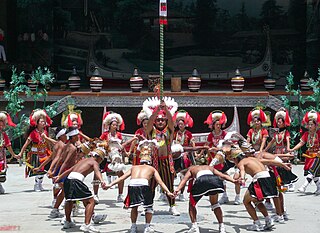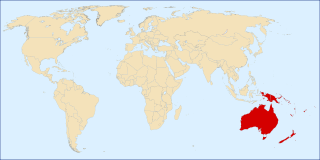
Oceania is a geographical region including Australasia, Melanesia, Micronesia, and Polynesia. Outside of the English-speaking world, Oceania is generally considered a continent, while Australia is regarded as an island or a continental landmass contained inside of the larger continent of Oceania. Spanning the Eastern and Western Hemispheres, at the centre of the water hemisphere, Oceania is estimated to have a land area of about 9,000,000 square kilometres (3,500,000 sq mi) and a population of around 44.4 million as of 2022. When compared to the continents, Oceania is the smallest in land area and the second-least populated after Antarctica.
A pidgin, or pidgin language, is a grammatically simplified means of communication that develops between two or more groups of people that do not have a language in common: typically, its vocabulary and grammar are limited and often drawn from several languages. It is most commonly employed in situations such as trade, or where both groups speak languages different from the language of the country in which they reside.

Tok Pisin, often referred to by English speakers as New Guinea Pidgin or simply Pidgin, is a creole language spoken throughout Papua New Guinea. It is an official language of Papua New Guinea and the most widely used language in the country. However, in parts of the southern provinces of Western, Gulf, Central, Oro, and Milne Bay, the use of Tok Pisin has a shorter history and is less universal, especially among older people.

Melanesia is a subregion of Oceania in the southwestern Pacific Ocean. It extends from New Guinea in the west to the Fiji Islands in the east, and includes the Arafura Sea.

Asia is home to hundreds of languages comprising several families and some unrelated isolates. The most spoken language families on the continent include Austroasiatic, Austronesian, Japonic, Dravidian, Indo-European, Afroasiatic, Turkic, Sino-Tibetan, Kra–Dai and Koreanic. Many languages of Asia, such as Chinese, Sanskrit, Arabic, Tamil or Telugu, have a long history as a written language.

Pacific Islanders, Pasifika, Pasefika, Pacificans, or rarely Pacificers are the peoples of the Pacific Islands. As an ethnic/racial term, it is used to describe the original peoples—inhabitants and diasporas—of any of the three major subregions of Oceania or any other island located in the Pacific Ocean.

A Spanish creole, or Spanish-based creole language, is a creole language for which Spanish serves as its substantial lexifier.
In addition to its classical and modern literary form, Malay had various regional dialects established after the rise of the Srivijaya empire in Sumatra, Indonesia. Also, Malay spread through interethnic contact and trade across the south East Asia Archipelago as far as the Philippines. That contact resulted in a lingua franca that was called Bazaar Malay or low Malay and in Malay Melayu Pasar. It is generally believed that Bazaar Malay was a pidgin, influenced by contact among Malay, Hokkien, Portuguese, and Dutch traders.

Melanesians are the predominant and indigenous inhabitants of Melanesia, in an area stretching from New Guinea to the Fiji Islands. Most speak one of the many languages of the Austronesian language family or one of the many unrelated families of Papuan languages. There are several creoles of the region, such as Tok Pisin, Hiri Motu, Solomon Islands Pijin, Bislama, and Papuan Malay.
In linguistics, Melanesian is an obsolete term referring to the Austronesian languages of Melanesia: that is, the Oceanic, Eastern Malayo-Polynesian, or Central–Eastern Malayo-Polynesian languages apart from Polynesian and Micronesian. A typical classification of the Austronesian languages ca. 1970 would divide them into something like the following branches:

The Indigenous peoples of Oceania are Aboriginal Australians, Papuans, and Austronesians. These indigenous peoples have a historical continuity with pre-colonial societies that developed on their territories. With the notable exceptions of Australia, New Zealand, Hawaii, New Caledonia, Guam, and Northern Mariana Islands, indigenous peoples make up the majority of the populations of Oceania.

There are three languages spoken in the Torres Strait Islands: two indigenous languages and an English-based creole. The indigenous language spoken mainly in the western and central islands is Kalaw Lagaw Ya, belonging to the Pama–Nyungan languages of the Australian mainland. The other indigenous language spoken mainly in the eastern islands is Meriam Mir: a member of the Trans-Fly languages spoken on the nearby south coast of New Guinea and the only Papuan language spoken on Australian territory. Both languages are agglutinative; however Kalaw Lagaw Ya appears to be undergoing a transition into a declensional language while Meriam Mìr is more clearly agglutinative. Yumplatok, or Torres Strait Creole, the third language, is a non-typical Pacific English Creole and is the main language of communication on the islands.

The Austronesian peoples, sometimes referred to as Austronesian-speaking peoples, are a large group of peoples in Taiwan, Maritime Southeast Asia, parts of Mainland Southeast Asia, Micronesia, coastal New Guinea, Island Melanesia, Polynesia, and Madagascar that speak Austronesian languages. They also include indigenous ethnic minorities in Vietnam, Cambodia, Myanmar, Thailand, Hainan, the Comoros, and the Torres Strait Islands. The nations and territories predominantly populated by Austronesian-speaking peoples are sometimes known collectively as Austronesia.

Papua New Guinea, a sovereign state in Oceania, is the most linguistically diverse country in the world. According to Ethnologue, there are 840 living languages spoken in the country. In 2006, Papua New Guinea Prime Minister Sir Michael Somare stated that "Papua New Guinea has 832 living languages ."
The word banua or vanua – meaning "land," "home," or "village" – occurs in several Austronesian languages. It derives from the Proto-Austronesian reconstructed form *banua. The word has particular significance in several countries.

The following outline is provided as an overview and topical guide to Oceania.

Oceanian culture encompasses the collective and diverse customs and traditions of art, architecture, music, literature, lifestyle, philosophy, politics and religion that have been practiced and maintained by the many ethnic groups of the geographical region of Oceania since prehistory. Cultures of Oceania reflect not only that of the region's indigenous peoples, but also the cultures brought by European colonisation and the United States, particularly through mass culture such as cinema and TV. Oceania is commonly divided into four geographic sub-regions, characterized by shared cultural, religious, linguistic, and ethnic traits: Australasia, Melanesia, Micronesia, and Polynesia. Most Oceanian countries are multi-party representative parliamentary democracies, and tourism is a large source of income for the Pacific Islands nations.












